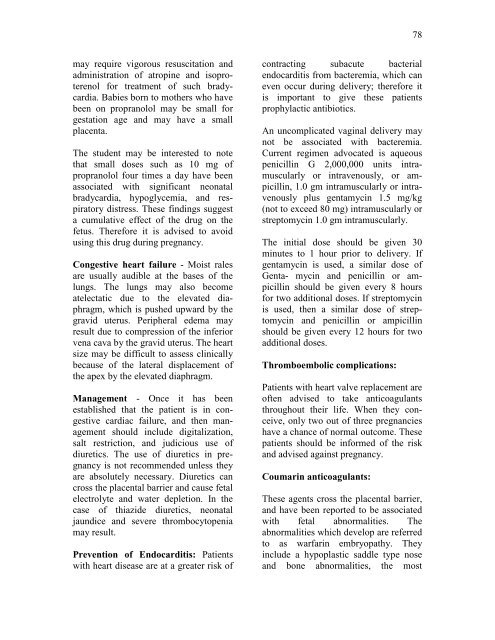Book of Medical Disorders in Pregnancy - Tintash
Book of Medical Disorders in Pregnancy - Tintash
Book of Medical Disorders in Pregnancy - Tintash
You also want an ePaper? Increase the reach of your titles
YUMPU automatically turns print PDFs into web optimized ePapers that Google loves.
may require vigorous resuscitation and<br />
adm<strong>in</strong>istration <strong>of</strong> atrop<strong>in</strong>e and isoproterenol<br />
for treatment <strong>of</strong> such bradycardia.<br />
Babies born to mothers who have<br />
been on propranolol may be small for<br />
gestation age and may have a small<br />
placenta.<br />
The student may be <strong>in</strong>terested to note<br />
that small doses such as 10 mg <strong>of</strong><br />
propranolol four times a day have been<br />
associated with significant neonatal<br />
bradycardia, hypoglycemia, and respiratory<br />
distress. These f<strong>in</strong>d<strong>in</strong>gs suggest<br />
a cumulative effect <strong>of</strong> the drug on the<br />
fetus. Therefore it is advised to avoid<br />
us<strong>in</strong>g this drug dur<strong>in</strong>g pregnancy.<br />
Congestive heart failure - Moist rales<br />
are usually audible at the bases <strong>of</strong> the<br />
lungs. The lungs may also become<br />
atelectatic due to the elevated diaphragm,<br />
which is pushed upward by the<br />
gravid uterus. Peripheral edema may<br />
result due to compression <strong>of</strong> the <strong>in</strong>ferior<br />
vena cava by the gravid uterus. The heart<br />
size may be difficult to assess cl<strong>in</strong>ically<br />
because <strong>of</strong> the lateral displacement <strong>of</strong><br />
the apex by the elevated diaphragm.<br />
Management - Once it has been<br />
established that the patient is <strong>in</strong> congestive<br />
cardiac failure, and then management<br />
should <strong>in</strong>clude digitalization,<br />
salt restriction, and judicious use <strong>of</strong><br />
diuretics. The use <strong>of</strong> diuretics <strong>in</strong> pregnancy<br />
is not recommended unless they<br />
are absolutely necessary. Diuretics can<br />
cross the placental barrier and cause fetal<br />
electrolyte and water depletion. In the<br />
case <strong>of</strong> thiazide diuretics, neonatal<br />
jaundice and severe thrombocytopenia<br />
may result.<br />
Prevention <strong>of</strong> Endocarditis: Patients<br />
with heart disease are at a greater risk <strong>of</strong><br />
78<br />
contract<strong>in</strong>g subacute bacterial<br />
endocarditis from bacteremia, which can<br />
even occur dur<strong>in</strong>g delivery; therefore it<br />
is important to give these patients<br />
prophylactic antibiotics.<br />
An uncomplicated vag<strong>in</strong>al delivery may<br />
not be associated with bacteremia.<br />
Current regimen advocated is aqueous<br />
penicill<strong>in</strong> G 2,000,000 units <strong>in</strong>tramuscularly<br />
or <strong>in</strong>travenously, or ampicill<strong>in</strong>,<br />
1.0 gm <strong>in</strong>tramuscularly or <strong>in</strong>travenously<br />
plus gentamyc<strong>in</strong> 1.5 mg/kg<br />
(not to exceed 80 mg) <strong>in</strong>tramuscularly or<br />
streptomyc<strong>in</strong> 1.0 gm <strong>in</strong>tramuscularly.<br />
The <strong>in</strong>itial dose should be given 30<br />
m<strong>in</strong>utes to 1 hour prior to delivery. If<br />
gentamyc<strong>in</strong> is used, a similar dose <strong>of</strong><br />
Genta- myc<strong>in</strong> and penicill<strong>in</strong> or ampicill<strong>in</strong><br />
should be given every 8 hours<br />
for two additional doses. If streptomyc<strong>in</strong><br />
is used, then a similar dose <strong>of</strong> streptomyc<strong>in</strong><br />
and penicill<strong>in</strong> or ampicill<strong>in</strong><br />
should be given every 12 hours for two<br />
additional doses.<br />
Thromboembolic complications:<br />
Patients with heart valve replacement are<br />
<strong>of</strong>ten advised to take anticoagulants<br />
throughout their life. When they conceive,<br />
only two out <strong>of</strong> three pregnancies<br />
have a chance <strong>of</strong> normal outcome. These<br />
patients should be <strong>in</strong>formed <strong>of</strong> the risk<br />
and advised aga<strong>in</strong>st pregnancy.<br />
Coumar<strong>in</strong> anticoagulants:<br />
These agents cross the placental barrier,<br />
and have been reported to be associated<br />
with fetal abnormalities. The<br />
abnormalities which develop are referred<br />
to as warfar<strong>in</strong> embryopathy. They<br />
<strong>in</strong>clude a hypoplastic saddle type nose<br />
and bone abnormalities, the most


